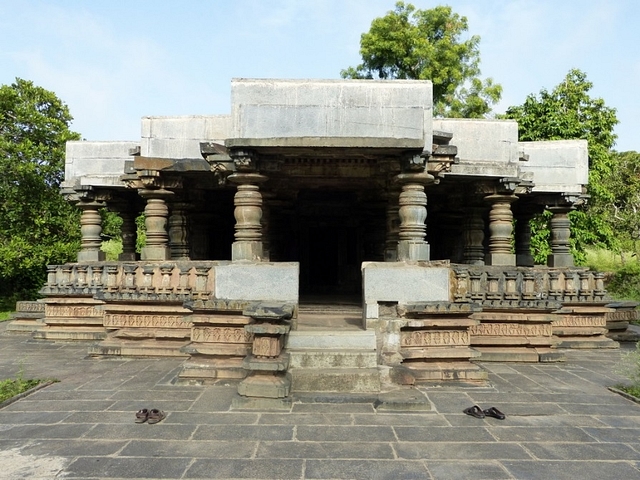
Exploring the historic Hanagal
When the Indians of the current generation come across the word Hanagal, they are most probably reminded of the legendary exponent of Hindustani music, one of the greatest Indian classical singers of the 20th century, Smt. Gangubai Hangal.
Indeed, a place named Hanagal, which is now a primary taluk headquarters in the Haveri district of Karnataka, is the birthplace of the renowned singer who spread the fame of the Khayal genre and the Kirana Gharana of Hindustani classical music not only to the different corners of India, but abroad too. The same town of Hanagal was once, during its thousands of years of history, one of the most prestigious locales for many of the well-known ruling kingdoms of Southern India – The Kadambas, the Chalukyas of Kalyana, the Hoysalas and the Seunas.
The region of Hanagal, which has been referred to as Panungal, Hanungallu and Hanagallu-500 in the inscriptions historically, was the focal point where different dynasties fought for the reigns of the present day northern Karnataka and southern Maharashtra regions. By conquering the famous Hanagal Fort, Hoysala king Vishnuvardhana announced himself as an alternative to the incumbent Kalyani Chalukyas, and by reconquering the same fort again in a few decades time, his grandson and Hoysala ruler Ballala the Second (Veera Ballala II) announced the independence of Hoysalas from the Kalyani Chalukyas.
The Temples of Hanagal
The city of Hanagal, which has a rich historical and cultural heritage, boasts of many temples constructed from the 11th through 13th centuries CE. One of the prime examples of the richness of the Western Chalukya architecture is the huge Tarakeshwara Temple (picture 1) dedicated to Lord Shiva that shines right in the middle of Hanagal town today. The extraordinarily huge and intricate carvings seen in the depiction of an upside down lotus design on the primary domical ceiling of the shrine is sculpting brilliance at its pinnacle (picture 2).
The entire temple is exceptionally symmetric in its design, with an unusually elongated structure leading to the main sanctum that hosts the Shiva Linga of Tarakeshwara. The length of the temple is due to the two mukha mantapas one behind the other that lead to the main sanctum, supported by ornate pillars that are both beautiful and large in number. Stories of Ramayana adorn the friezes of the outer walls along with the usual large keertimukhas seen commonly among the temples of the later Chalukya era. The temple had received funding from the Kadambas, the Kalyani Chalukyas and the Hoysalas among others.
The Hoysala emblem of Sala slaying a lion can be seen on the main shikhara as well as at the open entrance doorway to the temple complex, although both these images have been damaged. Within this temple complex, to the front left corner of the Tarakeshwara temple, there is also a temple dedicated to Lord Ganesha, which looks as old as the main temple with its typical Kadamba architecture.
Hanagal, however, is also home to many other lesser known historical monuments, most of which are quickly getting dilapidated in the absence of proper care. For example, there is a simplistic looking Billeshwara Temple (picture 3), again dedicated to Lord Shiva, on the banks of the Anekere Lake on the outskirts of Hanagal town. Only the main sanctum remains standing, and getting closer to the temple helps one witness the extensive carvings on the five columnar friezes that surround the doorway.
Also present in the erstwhile fort area of Hanagal is the Veerabhadra Temple (picture 4), another shrine from the Chalukya period. Though a simple plan, the grandeur of the Western Chalukya architecture is very much evident through the lathe turned pillars and the elaborately carved keertimukhas on the outer walls. The main shrine has been restored, possibly after the original one was ruined, and there are indications of recent repair job done to many other parts of the ceiling too.
There isn’t much left of the historic Hanagal fort, but while exploring the area that has now become acres and acres of farm land, it is very easy to miss out on another piece of architecture in the middle of the lush greenery (pictures 5 and 6).
Completely in ruins and shrouded almost entirely in bushes is a very ancient temple, whose details are not very well known even to the local residents. Some of them could tell that the temple was dedicated to a female god, although they could not elaborate on it much further. Henry Cousens, who captured a photograph of this temple in 1885, refers to this as a Jain Temple. That photograph is still available through the British Library Archives (picture 7) and it is clear that the temple was already in ruins back then, which has only gotten worse now. Despite all the destruction and the growth of shrubs along the collapsed main shrine, the extended lathe turned pillars of the temple give an indication of the spectacle the temple once was.
As one moves along the edges of these farms, it is easy to notice artefacts that appear to be from the bygone era lying around without much fanfare and not getting the necessary attention, even as the routine town life carries on. One such relic was a stone wheel, which was left unattended in a cottage (picture 8). It is intriguing to even think of the possibilities that might emerge in terms of historical evidences if a dedicated archaeological study is carried out in and around Hanagal.
How to reach Hanagal
Hanagal town is well connected by road and rail within the state of Karnataka. The town is about 380 kilometres from the state capital Bengaluru. Travelling on the national highway 4 from Bengaluru towards Pune, after crossing Chitradurga, Davanagere and Haveri, one needs to take a left turn at Bankapura to reach Hanagal. Haveri is also the nearest railway station.